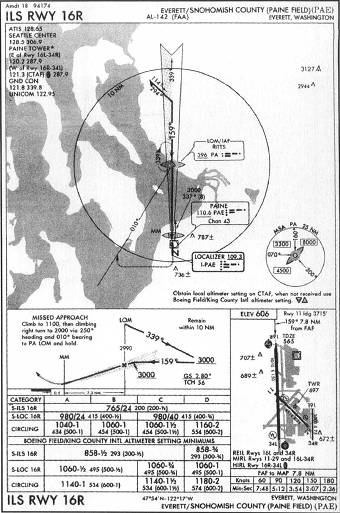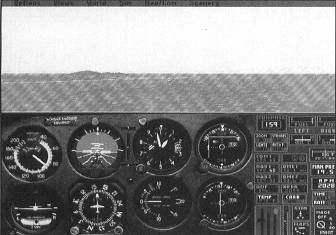Microsoft Flight Simulator Handbook
by Jonathan M. Stern
ILS Approach with Component Failures
Occasionally the glideslope transmitter on the ground becomes inoperative, or the glideslope receiver in the aircraft fails. In such a situation, a localizer approach may be made in lieu of a full ILS IAP. Because the glideslope is unavailable, the localizer approach is a non-precision approach and is made to an MDA, not a DH.
To simulate this situation, you have a choice. You can use your NAV 2, which has no glideslope receiver. You can also use the NAV 1 radio and pretend that the glideslope is inoperative.
For this approach, recall the No Paine, No Gain situation that you saved on the way from Port Angeles to Everett, Washington. Study the ILS RWY 16R IAP to Everett shown in Figure 18.64.

You will fly the ILS Rwy 16R IAP as a localizer-only approach:
- Because the No Paine, No Gain situation used an overcast layer slightly below your MDA for this approach, you need to modify the weather. Program overcast clouds with a 1,000 foot base to tops at 7,500 feet.
- No Paine, No Gain was saved when you were over the top of the Paine VOR-DME at 6,000 feet. Set the NAV 2 to the localizer frequency, and rotate the OBS until the OBI reads the inbound course for the approach.
- Unpause and track the localizer outbound while descending to 3,000 feet. Track outbound past the outer marker and execute the procedure turn.
- When you're established on the inbound course, maintain 3,000 feet until crossing the outer marker. Note the time that you cross the outer marker. The missed approach point is determined by elapsed time on a localizer-only approach unless the approach is also equipped with DME, which this one is not. The time-distance table at the bottom-right of the IAP chart provides the elapsed times to fly from the outer marker to the missed approach point at various groundspeeds.
For example, if your groundspeed is 90 knots, it takes five minutes and 12 seconds. Time is also used to determine the missed approach point for non-terminal VOR and NDB approaches. DME, however, may be used instead of time on VOR approaches using VORTACs or VOR-DMEs as the primary NAVAID.
- After crossing the outer marker, descend to 980 feet, the MDA (not DH because there is no glideslope) for this localizer-only approach. (See Figure 18.65). S-LOC 16R stands for straight-in localizer approach to runway 16R.
Figure 18.65. The airplane can reach the MDA long before elapsed time marks the missed approach point.
- Maintain 980 feet until you have the runway in sight and are in a position from which a normal landing can be made, or until your approach time runs out.
Time should run out at about the same time you pass over the middle marker.
- If you have the field in sight and are in a position from which a normal landing can be made, make the landing and complete the flight.
- Remember that this was the flight during which you were to play the role that Jack Warden played in the movie And Justice For All. If you made it this far, presumably you are in a fuel-critical situation. Use the Sim/Fuel menu to check how much fuel remains. If your flight planning was accurate (and the weather was as you believed), there should be not more than one or two gallons of usable fuel in your tanks. Remember that the Federal Aviation Regulations require a minimum IFR fuel reserve of 45 minutes at cruise airspeed.
Table of Contents
Previous Section: Night ILS Approach
Next Section: European ILS Approaches
